A new study paints an unexpected picture of strange cosmic bursts that scientists have been researching since 2007, finding one that repeats in a 157-day pattern. These bursts last only a few milliseconds but are detectable from Earth due to their extremely high energy.
Fast radio bursts (FRBs) have been observed in repeating patterns only once before, and have been discovered using artificial intelligence to sift through large amounts of telescope data. They have also been used as research tools themselves, shedding light on mysterious galactic halos and even helping to find the universe’s missing matter.
However, scientists still aren’t sure what the cause of the bursts is and where they originate from.
Using the Lovell Telescope at the Jodrell Bank Observatory in the United Kingdom, astronomers observed an FRB called 121102 for four years and spotted 32 bursts. These bursts repeated in a cyclical pattern that repeats every 157 days — with bursts coming in the first 90 period, followed by 67 days of silence, before the bursts begin once again.

As these bursts are regular, that suggests they could be caused by the motion of bodies such as the orbiting motion of a black hole or neutron star. Previous theories had suggested that the bursts may be caused by a “precessing” neutron star, wobbling like a spinning top, but the long period of inactivity observed in this FRB suggests that’s not likely.
Dr. Kaustubh Rajwade of The University of Manchester, leader of the research, explained in a statement: “This is an exciting result as it is only the second system where we believe we see this modulation in burst activity. Detecting a periodicity provides an important constraint on the origin of the bursts and the activity cycles could argue against a precessing neutron star.”
The finding of periods of inactivity may be just as informative as the periods of activity, according to the researchers. The only other periodic FRB observed to date had a much shorter cycle of just 16 days, while these new findings point to a timescale almost ten times longer than that.
“This exciting discovery highlights how little we know about the origin of FRBs,” researcher Duncan Lorimer said in the statement. “Further observations of a larger number of FRBs will be needed in order to obtain a clearer picture about these periodic sources and elucidate their origin.”
Editors' Recommendations
- The expansion rate of the universe still has scientists baffled
- James Webb spots tiniest known brown dwarf in stunning star cluster
- James Webb spots carbon dioxide on Europa, supporting theory of habitability
- Scientists explain cosmic ‘question mark’ spotted by Webb space telescope
- Webb spots water vapor in a planet-forming disk




